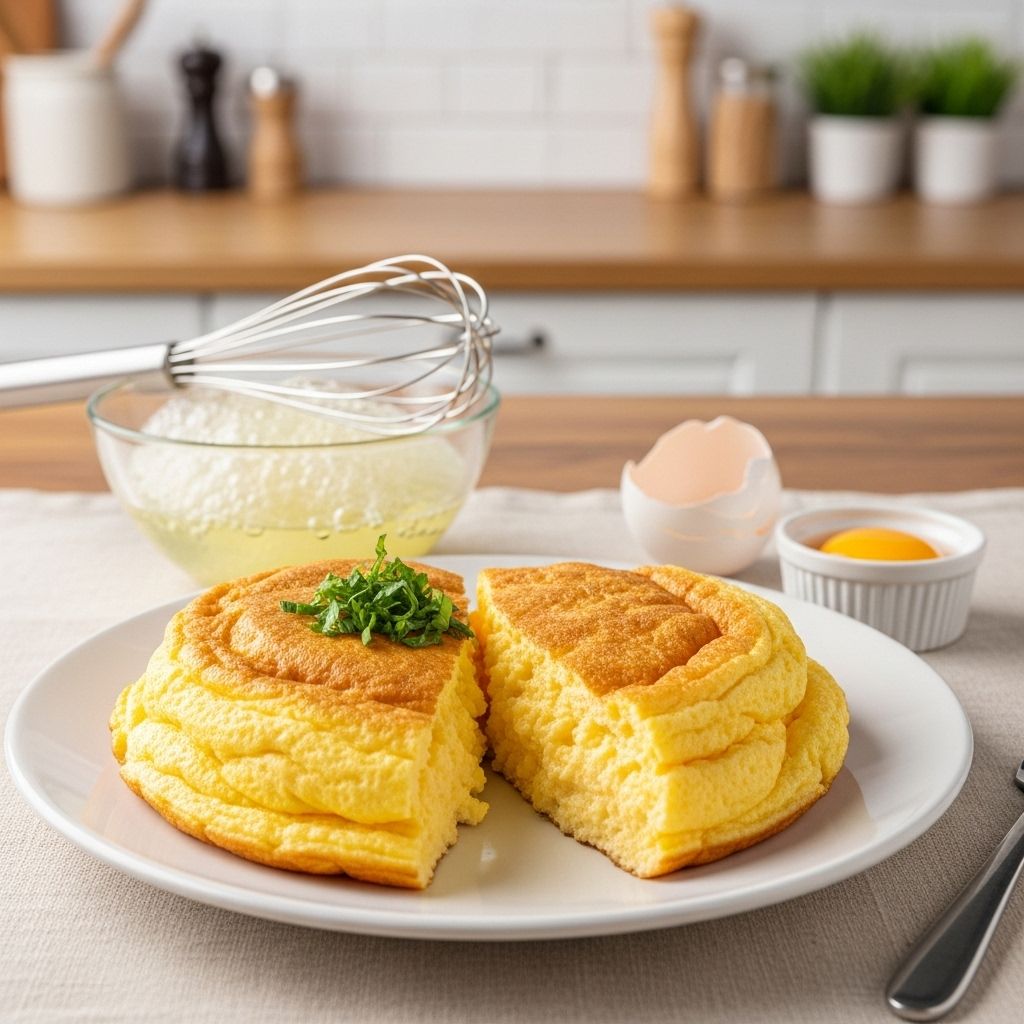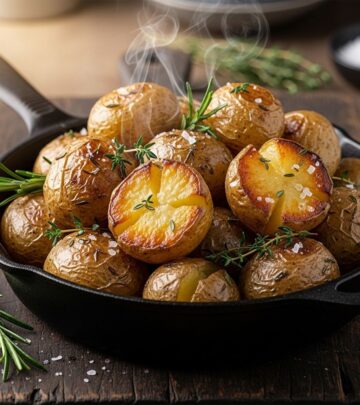Fluffy Omelet Recipe: Step-By-Step Guide For Cloud-Like Eggs
Transform ordinary eggs into an extraordinarily fluffy breakfast delight with this foolproof technique

Image: HearthJunction Design Team
Introduction to the Super Fluffy Omelet
The super fluffy omelet, also known as a souffle omelet, is a delightful breakfast creation that transforms ordinary eggs into a cloud-like culinary experience. Unlike traditional flat omelets, this version incorporates special techniques that create a light, airy texture that rises dramatically during cooking. Perfect for breakfast enthusiasts looking to elevate their morning routine, this recipe combines simplicity with impressive results that will make you feel like a professional chef in your own kitchen.
What sets this omelet apart is the method of separating egg whites from yolks and whipping them to create volume. This technique, borrowed from classic French cuisine, produces a dish that’s simultaneously rich and delicate. Whether you’re cooking for yourself or impressing guests at a weekend brunch, mastering the super fluffy omelet is a valuable addition to your culinary repertoire.
Why Choose a Fluffy Omelet?
The fluffy omelet stands out from its flatter counterparts for several compelling reasons. First, its impressive height and volume create a dramatic presentation that transforms an ordinary breakfast into something special. The texture is remarkably different – light and airy rather than dense, creating a melt-in-your-mouth experience that feels almost like eating a savory cloud.
From a nutritional perspective, fluffy omelets offer the same protein-rich benefits as traditional omelets but with a different eating experience. The incorporated air makes the omelet feel more substantial without adding calories. Additionally, this style of omelet serves as an excellent canvas for a variety of fillings and toppings, allowing you to customize based on seasonal ingredients or personal preferences.
Essential Ingredients for the Perfect Fluffy Omelet
Main Ingredients
At its core, a super fluffy omelet requires just a few quality ingredients:
- Eggs – Fresh eggs are crucial for achieving the best volume when whipping the whites. Ideally, use eggs at room temperature for optimal results.
- Salt – A pinch of fine sea salt enhances the egg flavor without weighing down the whites.
- Butter – Unsalted butter provides rich flavor and ensures the omelet doesn’t stick to the pan.
Optional Additions
While the basic fluffy omelet is delicious on its own, many recipes incorporate additional ingredients to enhance structure and flavor:
- Water or Milk – A small amount adds moisture and helps create steam during cooking for maximum rise.
- Flour – A tablespoon of all-purpose flour can provide subtle structure to help stabilize the whipped eggs.
- Cheese – Shredded mozzarella, cheddar, Swiss, or other melting cheeses add richness and flavor.
Essential Equipment
Creating a perfect fluffy omelet doesn’t require specialized equipment, but having the right tools will make the process easier:
- Non-stick skillet – An 8-inch non-stick skillet works perfectly for a 2-3 egg omelet.
- Mixing bowls – You’ll need separate bowls for egg whites and yolks.
- Whisk or electric mixer – While a hand whisk works, an electric mixer makes achieving stiff peaks much easier.
- Silicone spatula – Essential for gently folding ingredients without deflating the whipped egg whites.
- Flexible turner – Helps with flipping and serving the omelet without breaking it.
Step-by-Step Preparation Method
Separating the Eggs
The first and most crucial step in creating a super fluffy omelet is properly separating the eggs:
- Crack an egg and carefully transfer the yolk between the two halves of the shell, allowing the white to fall into a clean bowl below.
- Place the yolk in a separate bowl.
- Repeat with remaining eggs, being careful not to get any yolk in the whites (even a small amount can prevent proper whipping).
Preparing the Egg Mixture
Once your eggs are separated, it’s time to prepare both components:
- Add a pinch of salt to the egg whites.
- Using a whisk or electric mixer, beat the egg whites until they form stiff peaks. You’ll know they’re ready when you can turn the bowl upside down without the whites falling out.
- In a separate bowl, lightly beat the egg yolks until smooth.
- Gently fold the beaten yolks into the whipped egg whites using a spatula. Move the spatula in a cutting motion down through the mixture, across the bottom, and up the side. Rotate the bowl as you fold to incorporate evenly without deflating the whites.
Cooking the Perfect Fluffy Omelet
The cooking technique is what transforms your egg mixture into a towering, fluffy creation:
- Heat a non-stick skillet over medium heat and add butter, allowing it to melt and bubble slightly.
- Pour the egg mixture into the pan, using a spatula to spread it evenly.
- Reduce heat to low immediately to prevent burning the bottom before the center cooks.
- Cook for about 1-2 minutes until the bottom is set but the top is still slightly wet.
- For a stovetop-only method: Use a spatula to fold the omelet in half, cooking for another 30 seconds before sliding onto a plate.
- For a puffier finish: Transfer the skillet to a preheated 350°F oven for 2-3 minutes to finish cooking, which allows for more even rising.
Variations and Fillings
Classic Cheese
A classic cheese filling complements the fluffy texture perfectly. Sprinkle 1/4 cup of shredded cheese (mozzarella, cheddar, Swiss, or Monterey Jack work well) over half the omelet just before folding. The residual heat will melt the cheese to perfection.
Vegetable Options
Add vibrant flavor and nutrition with these vegetable additions:
- Fresh spinach – Add right before folding to wilt slightly from the heat.
- Sautéed mushrooms – Pre-cook until golden and moisture has evaporated.
- Diced bell peppers and onions – Sauté briefly before adding to ensure they’re tender-crisp.
- Asparagus – Thinly sliced and lightly cooked for a seasonal spring option.
Protein Additions
Turn your fluffy omelet into a more substantial meal with these protein options:
- Crispy bacon – Cook until crisp, chop, and sprinkle inside the omelet.
- Diced ham – Adds savory flavor without requiring additional cooking.
- Prosciutto – Paper-thin slices provide a sophisticated touch and salty contrast.
Garnishes and Toppings
Finish your masterpiece with these elegant touches:
- Fresh herbs – Chives, parsley, or dill add color and fresh flavor.
- Cherry tomatoes – Halved and placed alongside for brightness.
- Avocado slices – Add creamy richness and healthy fats.
- Toasted breadcrumbs – Provide a delightful textural contrast when sprinkled over the top.
Common Challenges and Troubleshooting
Deflating Egg Whites
One of the most common issues when making a fluffy omelet is egg whites that deflate before or during cooking. To prevent this:
- Ensure your mixing bowl is completely clean and free from any grease or residue.
- Use room temperature eggs for better volume.
- Be gentle when folding in yolks or other ingredients.
- Work quickly once the whites are whipped to prevent them from losing volume.
Uneven Cooking
If your omelet cooks unevenly with a burnt bottom and raw top:
- Ensure your heat is medium-low rather than high.
- Consider finishing the omelet in the oven for more even heat distribution.
- Use a properly sized pan – too large and the omelet will be too thin; too small and the center won’t cook properly.
Difficulty Folding
A properly made fluffy omelet should fold easily without breaking. If you’re having trouble:
- Make sure the bottom is fully set before attempting to fold.
- Use a thin, flexible spatula that can easily slide underneath the omelet.
- Consider making a smaller omelet until you master the technique.
Nutritional Benefits
The super fluffy omelet isn’t just delicious—it’s nutritious too. Eggs are powerhouses of nutrition, providing high-quality protein, vitamins B12 and D, selenium, and choline. A typical two-egg fluffy omelet delivers approximately 12-14 grams of protein, making it an excellent choice for a satisfying breakfast that helps maintain stable energy levels throughout the morning.
The cooking method used for fluffy omelets requires minimal added fat, and you can further control calorie content through your choice of fillings and toppings. Adding vegetables increases fiber, vitamins, and minerals, while cheese provides additional protein and calcium. For those monitoring cholesterol, egg white omelets offer a protein-rich alternative with zero cholesterol.
Serving Suggestions
A fluffy omelet makes for an impressive centerpiece to any breakfast or brunch. Here are some serving ideas to create a complete meal:
- Breakfast classic – Pair with toast and fresh fruit for a balanced morning meal.
- Brunch spread – Serve alongside roasted potatoes, crispy bacon, and a light mixed greens salad.
- Light dinner – For a quick evening meal, accompany with a cup of soup and crusty bread.
For presentation, consider serving on a warmed plate to maintain the omelet’s temperature and height as long as possible. A sprinkling of fresh herbs adds a professional touch that elevates the entire dish.
Frequently Asked Questions
Q: Can I make a fluffy omelet ahead of time?
A: Fluffy omelets are best enjoyed immediately after cooking. The soufflé-like texture will deflate and become rubbery if made ahead of time. If you need to prepare components in advance, you can pre-cook fillings like vegetables or meats and refrigerate them until needed.
Q: Why did my egg whites not whip to stiff peaks?
A: Several factors can prevent egg whites from whipping properly: traces of yolk or fat in the bowl, using cold eggs, or using a plastic bowl that might have residual grease. Make sure your bowl and beaters are completely clean, use room temperature eggs, and consider adding a tiny pinch of cream of tartar to help stabilize the whites.
Q: Can I make a fluffy omelet without separating the eggs?
A: While separating eggs creates the fluffiest result, you can achieve a somewhat fluffy omelet by vigorously beating whole eggs with a splash of water until very frothy, then cooking over low heat in a covered pan. The steam will help the omelet rise, though it won’t achieve the same height as the separated-egg method.
Q: How can I tell when my fluffy omelet is done cooking?
A: A properly cooked fluffy omelet should be lightly golden on the bottom, puffed up significantly, and just set on top. The center should not be runny, but it should still look moist. If you gently touch the center with a finger, it should feel set but still spring back slightly.
Q: Why does my omelet deflate so quickly?
A: Some deflation is normal and expected as the hot air inside the omelet cools. To minimize deflation, serve immediately after cooking and consider finishing the omelet in the oven, which provides more even heat and can help set the structure more firmly.
Conclusion
Mastering the super fluffy omelet is a rewarding culinary skill that transforms a simple breakfast into something special. The technique might take a practice attempt or two, but once you’ve experienced the light, airy texture and impressive visual appeal of this dish, it’s likely to become a regular in your cooking repertoire.
Remember that the key to success lies in properly whipped egg whites and gentle handling to maintain that volume. Don’t be discouraged if your first attempt isn’t perfect—each omelet teaches you something about temperature control, timing, and technique. With a bit of practice, you’ll be creating restaurant-worthy fluffy omelets that will delight family and friends alike.
Whether you prefer yours simply dressed with herbs or filled with your favorite ingredients, the super fluffy omelet offers endless opportunities for creativity while delivering a nutritious, satisfying meal. Happy cooking!
References
Read full bio of Shinta












